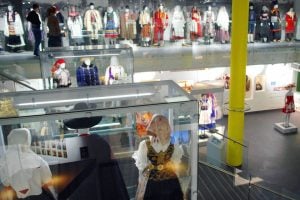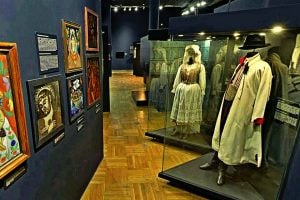Visit a glass showroom with folk costumes, a story about rituals, traditions, and objects that belong to different traditions and denominations in Poland and Europe takes up over 850 m² and it is told through thousands of exhibits. The exhibition’s style is very modern and resembles a shopping centre – well-lit interiors, dressed-up mannequins behind glass, drawers full of accessories and ornaments. It puts the traditionally understood notions of “folk” and “rustic” in a new context.
The folk “costume” is the key to the Celebration Time exhibition – a unique set of clothes worn for a feast that involves dancing, music, and rituals. Therefore, the exhibition aims to emphasise the variety of folk costumes by presenting over 100 festive outfits from Poland and Europe as well as a unique in the world collection of European folk dance models with miniature dancers wearing traditional folk costumes. The models were created for the International Exposition of Art and Technology in Modern Life held in Paris in 1937.
While presenting tradition, the exhibition also asks about the importance of folk style in mass culture and reveals the influence of folklore on fashion and applied arts, since the 1930s to our times. A gallery with folk instruments from Poland and other countries allows visitors to listen to now forgotten sounds of the sarangi, gadulki, or bandura. Visually, the atmosphere of rituals is re-created through valuable votive paintings, folk sculptures, Easter eggs, paper cut-outs, Christmas tree decorations and carnival-related items.
The permanent exhibition “Celebration Time in Polish and European Folklore” was created in 2013 to celebrate the Museum’s 125th anniversary.
In the modern, two-storey exhibition hall, that incorporates big showroom aesthetics, you can admire a collection of the most beautiful folk costumes from Poland and Europe, ritualistic accessories, religious art, fabrics, decorative ceramics and woodcarving.
Folklore collection
The folklore collection consists of a group of objects which are particularly fragile and difficult to preserve. The most significant of these is the group of Easter eggs.
Music and Dance
Music and Dance – annex to the permanent exhibition “Celebration Time in Polish and European folklore”.
The exhibition is a journey to the roots of Frederic Chopin’s music, with the help of rustic melodies and folk instruments. Here, the world of the great composer’s music is intertwined with authentic sounds of a traditional Poland; at the same time, it introduces the listener to sounds, scales, and rhythms from around the world – Greece, the Balkans, Iran, India, and Africa.
Jewish Festivities
Before World War II, celebrations took place in thousands of Jewish families in countless cities, towns and villages. That’s the reason why the exhibition “Celebration Time” is accompanied with a Judaic Annex. When entering the annex, one must pass an original, renovated sukkah from the town of Szydłowiec (the Mazovia region).
In the Judaic annex we present the town of Gąbin (Gombin in the Ashkenazi spelling), in the Mazovia region, a birthplace of a renown 17th century rabbi Abraham Gombiner and an Yiddish poet Rajzel Zychlinsky. A visitor can watch an amateur black-and-white film shot by Sam Rafel in 1939, showing the town and its citizens. We also present a model of a wooden synagogue burnt in 1939, made by Wojciech Wasilewski.
National Ethnographic Museum in Warsaw
The National Ethnographic Museum is a space where the achievements of world culture meet with individual sensitivity, becoming an inspiration to discover the beauty of diversity.
The State Ethnographic Museum – one of the oldest ethnographic museums in Poland. The museum was founded in 1888 and houses over 80,000 objects and about 120,000 archives. The Ethnographic Museum presents several permanent exhibitions and over a dozen temporary exhibitions a year.
In modern interiors, we present permanent and temporary exhibitions of interdisciplinary character and diverse themes. The autonomous structure of our institution is dedicated to the youngest Children’s Museum, where you can touch everything. The museum also has a library and the Antropos cinema with an unconventional repertoire. In the Bílý Koníček café you can get acquainted with the offer of the bookstore and shop while drinking coffee. In addition, the museum hosts trade fairs, special events, meetings with authors, workshops and seminars. Therefore, we encourage you to actively participate in culture – children, youth and adults.
National Ethnographic Museum diversity and richness of cultures around the world and present their values as a nationwide good, thus contributing to the development of an open society.







